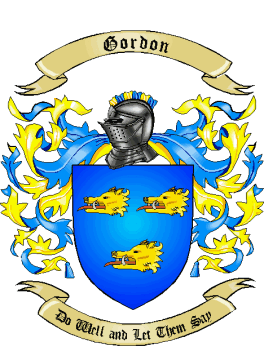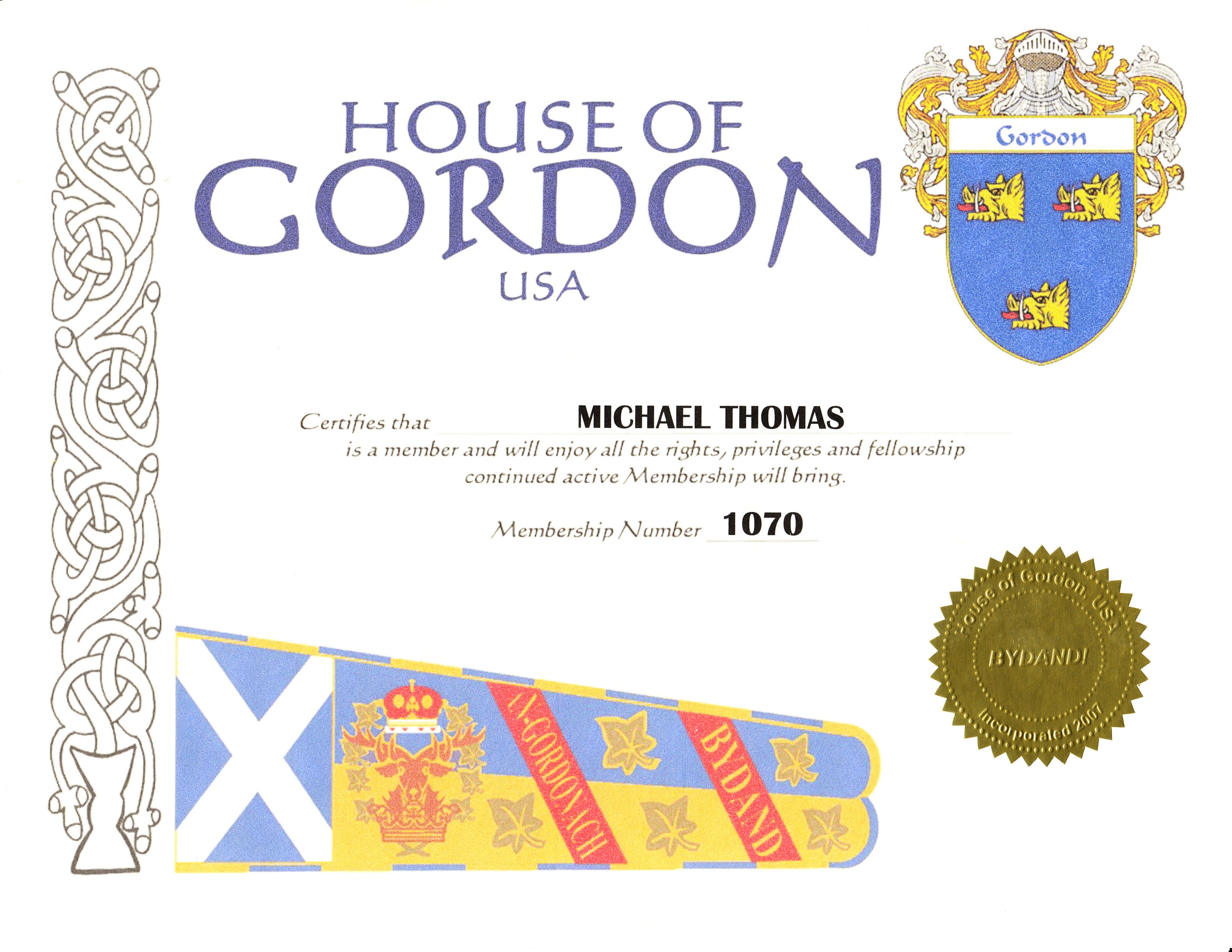Category: Clan Gordon
A part of Scottish Clans - Wikitree.com
Clan Manager - Michael Thomas

Coat of Arms - Most Honorable Granville Charles Gordon, 13th Marquess of Huntly
Michael Thomas
Clan Links - Gordon to Murray
Alexander, 1st Earl of Huntly, Gordon (1410-1470 - 15th Great Grandfather
Alexander, 1st Lord of Gordon, Seton (1385-1441) – 16th Great Grandfather
Married Elizabeth Seton Gordon (1384-1439) – 16th Great Grandmother
Sir William, 1st Lord of Seton (1343-1424) – 17th Great Grandfather
Alan de Wyntown of Seton (1298-1347) - 18th Great Grandfather
Margaret Murray (1275- ) – 19th Great Grandmother
Married Baron Alan de Wyntown (1274-1355) – 19th Great Grandmother
Andrew Moray (1249-1297) – 20th Great Grandfather
Andrew Moray (1222-1249) – 21st Great Grandfather
Sir William, 1st Lord of Bothwell, Murray (1195-1244) – 22nd Great Grandfather
Sir William, 1st Lord of Washington, de Moravia (1164-1195) – 23rd Great Grandfather
Married Margaret Bruce (1169-1188) – 23rd Great Grandmother
William Freskin de Moray (1139-1204) – 24th Great Grandfather
Freskin le Fleming de Moravia (1107-1172) – 25th Great Grandfather
Robert II le Fleming, Count of Flanders (1065-1111) – 26th Great Grandfather
Clan Name - GORDON (aka House of Gordon)
Extracted from a letter written by Lois Todd, President, House of Gordon USA
The House of Gordon has a long and proud history. Coming into Scotland with Malcolm III to help him regain his throne, the Gordons were rewarded with lands in the Roxburgh District near Kelso in the Borders. In 1320, Adam Gordon was rewarded for his support of Robert the Bruce and the Scottish War of Independence under English rule with Strathbogie and its lands in Aberdeenshire. Later, Strathbogie was renamed Huntly to match the Gordon title.
This brought the main branch of the family into the Highlands and began the Gordon rise to power. At its zenith, the Gordon Clan Chief could have destabilized the Scottish throne if he had so chosen. His power in the northeast of Scotland was unrivaled, and he commanded the resources of all branches of the family at one time, including Clan Sutherland as a cadet branch of Clan Gordon. The Clan Chief became known as the "Cock of the North."
Since the late 15th Century, there have been branches of the family in Spain, Belgium, Russia, the Americas, and later Australia and New Zealand. Because we had our origins in Normandy and held lands in the Lowlands and Highlands, and had ties to the royal house of Scotland, Clan Gordon has long called itself the House of Gordon, and the two names are now used interchangeably.
Adapted from an article on ElectricScotland.com
The Gordons are an ancient and distinguished family, originally from Normandy, where their ancestors are said to have had large possessions. It is probable that the first Gordons in Scotland came over with William the Conqueror in 1066. According to Chalmers, the founder of this great family came from England in the reign of David I (1124-1153), and obtained the lands of Gordon (Gordun, or Gordyn, from the Gaelic Gordin, "on the hill"). He left two sons, Richard and Adam, who, although he was the younger son, had a portion of the territory of Gordon, with the lands of Fanys on the southern side of it.
The elder son, Richard de Gordon, granted, between 1150 and 1160 land to the monks of Kelso. After his death in 1200, his son, Sir Thomas de Gordon. confirmed the donations, and his son and successor, also named Thomas, made additional grants to the same monks, as well as to the religious of Coldstream. He died in 1285, without male issue. His only daughter, Alicia, married her cousin Adam de Gordon, the son of Adam, younger brother of Richard, and the two branches of the family became united.
His grandson, Sir Adam de Gordon, Lord of Gordon, one of the most eminent men of his time, was the progenitor of most of the Gordons in Scotland. As a reward for his faithful service, Bruce granted him and his heirs the noble lordship of Strathbolgie (now Strathbogie), in Aberdeenshire, then in the Crown, by the forfeiture of David de Strathbogie, Earl of Atholl. Sir Adam resided there, and gave these lands and lordship the name of Huntly, from a village of that name in the western extremity of Gordon parish, in the Merse, the site of which is now said to be marked only by a solitary tree. From their northern domain, the family afterwards acquire the titles of Lord, Earl, and Marquis of Huntly, and the latter is now their chief title.
Sir Adam was slain, fighting bravely in the vanguard of the Scottish army at the battle of Halidonhill, July 12, 1333. By Annabella, his wife, supposed to have been a daughter of David de Strathbolgie, he had four sons and a daughter. The eldest son, Sir Alexander, succeeded him. The second son, William, was ancestor of the Viscounts of Kenmure.
Sir John Gordon, his great-grandson, got a new charter from King Robert the Second of the lands of Strathbogie, dated 13th June 1376. He was slain at the battle of Otterbourne in 1388. His son, Sir Adam, lord of Gordon, fell at the battle of Homildon, 14th September 1402. By his wife, Elizabeth, daughter of Sir William Keith, great marshal of Scotland, he had an only child, Elizabeth Gordon, who succeeded to the whole family estates and married Alexander Seton, second son of Sir William Seton of Seton, ancestor of the Earls of Winton. Alexander was styled lord of Gordon and Huntly, and left two sons, the younger of whom became ancestor of the Setons of Meldrum.
Alexander, the elder, was created Earl of Huntly in 1449, with limitation to his male heirs, by Elizabeth Crichton, his third wife, they being required to bear the name and arms of Gordon. George, the sixth earl, was created Marquis of Huntly by King James, in 1599. George, the fourth marquis, was made Duke of Gordon in 1684. George, fifth duke, died without issue on 28 May 1836. At his death the title of Duke of Gordon became extinct, as well as tha of Earl of Norwich in th British peerage, and the Marquisate of Huntly devolved on George Earl of Aboyne, descended from Charles, fourth son of George, second Marquis of Huntly, while the Duke of Richmond and Lennox, son of his eldest sister, succeeded to Gordon castle, Banffshire, and other estates in Aberdeenshire and Inverness-shire.
The clan Gordon was, at one point, the most powerful and numerous in the north. Although the chiefs were not originally Celtic in origin, they gave their name to the clan, the distinctive badge of which was the rock ivy. The clan feuds and battles were frequent, especially with the Mackintoshes, the Camerons, the Murrays, and the Forbes.
The Duke of Gordon, who was the chief of the clan, was usually styled "The Cock of the North". His most ancient title was the "Gudeman of the Bog", from the Bog-of-Gight, a morass in the parish of Bellie, Banffshire, in the centre of which the former stronghold of this family was placed, and which forms the site of Gordon castle, considered the most magnificent edifice in the north of Scotland. The Marquis of Huntly is now the chief of the clan Gordon. Of the name Gordon, there are many ancient families belonging to Aberdeenshire, Banffshire and the north of Scotland.
Clanmans Badge:
Motto: BYDAND (abiding or steadfast, a use of the Middle Scots present participle of 'bide' or a contraction of the Scots phrase 'Bide and Fecht,' meaning to stand and fight. Slogan/War Cry: An Gordonach (A Gordon!)
Banner: The Standard of the Gordon Clan consists of a pennant shaped flag. On the hoist is St. Andrew's Cross. The fly is divided horizontally in azure and or (blue and gold).
On the fly is the Crest of the Marquis of Huntly and two oblique red sashes with the Clan War Cry 'AnGordonach', the Clan Motto 'Bydand', all interspersed with five leaves of rock ivy.
The Standard was used as a rallying point for the Clan in battle and contained the Clan Insignia which were readily recognizable to the clansmen. All Scottish Standards contain the St. Andrew's Cross on the hoist.
Region: Highlands
District: Aberdeenshire
Plant badge: Rock Ivy
Music: Gordons March ; Cock o' the North (audio - video) ; Gordon Salute
Septs: - Ackane, Adam(son), Ad(d)i.e., Addison, Adkins, Aiken, Aitchison, Aitken, Akane, Akins, Atkin, Atkins(on), Badenoch, Barrie, Connor, Connon, Cote, Craig, Cromb(i.e.), Cullen, Culane, Darg(e), Dorward, Duff, Durward, Eadie, Ed(d)i.e., Edison, Esslemont, Garden, Gard(i)ner, Garioch, Garr(o)ick, Geddes, Gerr(y)ie, Harrison, Haddo(w), Huntl(e)y, Jeffrey, Jessiman, Jopp, Jupp, La(i)ng, Laurie, Lawrie, Leng, Ling, Long, MacAdam, MacGwyverdyne, Mallett, Manteach, Marr, Maver, McGonigal, Meldrum, Mill, Mills, Milles, Miln(e)], Milner, Moir, More, Morrice, Muir, Milnes, Mylne, Pittendri(e)gh, Shellgren, Steel(e), Teal, Tod(d), Troup
Names associated with the clan: - Gordon of Huntly (chiefs), Gordon of Haddo, Gordon of Lochinvar, Gordon of Strathbogie
Allied clans: Clan Seton, Clan Sutherland, Clan Burnett
Rival clans: Clan Lindsay, Clan Douglas, Clan Forbes, Clan Leask





